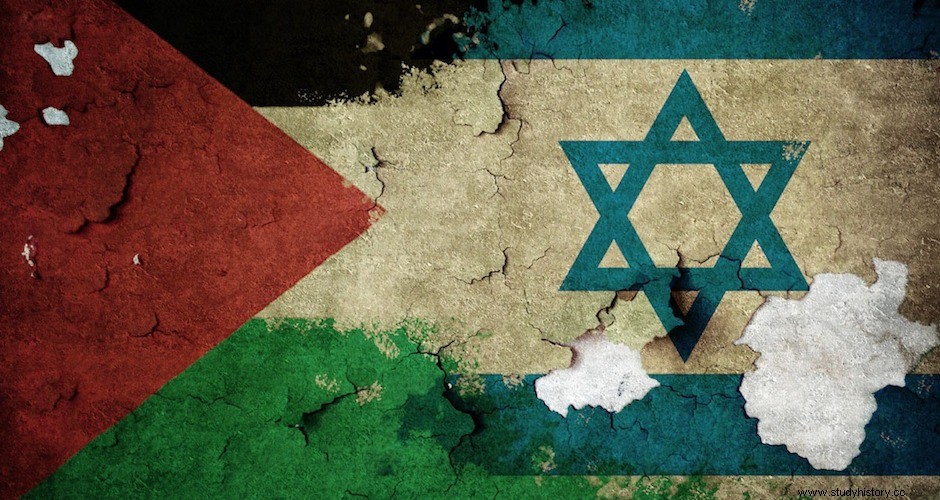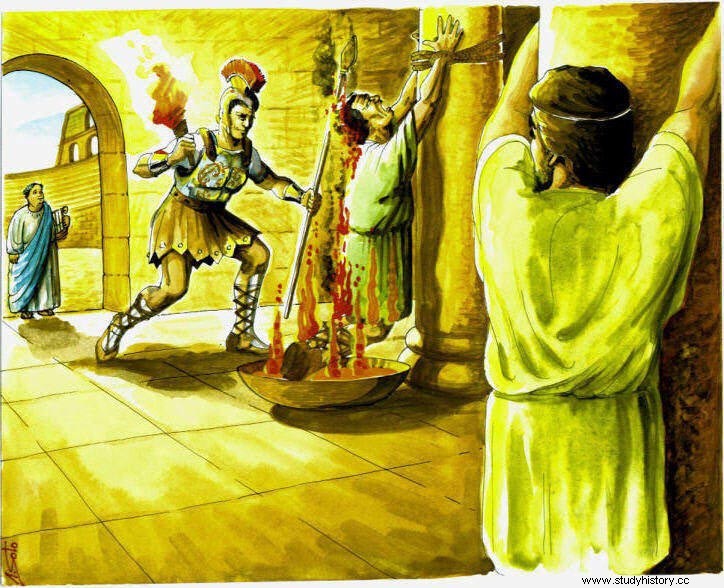Encouraged by the anti-Semitism suffered by the Jews in Europe, at the beginning of the 20th century the Zionist movement founded by Theodor Herzl gained strength. that defended the regrouping of the Jewish population dispersed throughout the world, choosing Palestine as the place of settlement of its members, since it had been the land where Judaism was founded. The region of Palestine, between the Jordan River and the Mediterranean Sea, considered sacred to Muslims, Jews and Catholics, was controlled by the Ottoman Empire since 1517 and occupied mainly by Arabs. But a strong Jewish immigration, encouraged by Zionist aspirations, began to settle in that territory.

In 1917, during the First World War, the so-called Balfour Declaration was signed. , in which the British government pledged to support the creation of a "national home for the Jewish people" in the region of Palestine. After the disintegration of the Ottoman Empire in the First World War, the United Kingdom received a mandate from the League of Nations to administer the territory of Palestine, broke the promises of independence that had been made to the Arabs by rising against the Turks and allowed the Jews began to create autonomous institutions. This caused a climate of tension between Arab nationalists and Zionists that triggered clashes.
With the arrival in Germany of Adolf Hitler to power, the migration of Jews to Palestine multiplied, which worsened the coexistence with the Palestinian Arabs, giving rise to strong disputes and revolts between the two. Once the Second World War was over, Great Britain decided to leave the problem of the coexistence of both religions in the hands of the UN. In 1947, the UN decided that the British Mandate of Palestine should be divided into two states, one Jewish and one Arab, and Jerusalem would come under an international mandate. This decision was accepted by the Israelis (who were awarded 55% of the territory) but not by the Palestinians. After the British officially left the Palestinian territory, the Israeli Prime Minister, David Ben-Gurion , declared the State of Israel in 1948. The next day, a coalition of Arab countries (made up of Egypt, Syria, Transjordan, Lebanon, and Iraq) that did not accept the resolution and supported Palestine, began a war against the Jews. And since that day, 70 years dotted with wars, street clashes, settlements, walls, attacks and peace agreements that were too short.
And if the creation of the State of Israel was the flame that definitively lit the fuse, a Hispanic, the emperor Hadrian , was the one who planted the seed of the conflict in the year 135 after quelling the revolt of the «Jewish Messiah «.

Emperor Hadrian
Simon bar Kokhba (שמעון בן כוסבא), also called ben Koziba (בן כוזיבא) in other sources, who led the great rebellion of the Jews against the Roman Empire. The name of this enemy of Rome entered history when the Taná Raví Akiva ben Yosef , rabbinical scholar and influential person of the Sanhedrin, granted him the name of Bar Kokeba (from the Aramaic “Son of a Star”, referring to the Bible verse Numbers 24:17, “A star will descend from Jacob ”) In this way, Akiva pointed to Ben Kochba as the authentic Messiah who would liberate the Jewish people from his oppressors.
But why did this Akiva stoke a full-fledged rebellion against the Roman authorities? The explanation is simple:after the capture of Jerusalem by the troops of the Emperor Vespasian's son, Titus , in the year 70, the delicate balance between Roman government and Jewish tradition that had begun with Herod was broken. The city was fiercely looted, the Temple burned and destroyed, and many of the sacred elements of the Jewish cult ended up exhibited as Flavian's booty during his Triumph through the streets of Rome. To the religious humiliation was added the almost one hundred thousand dead and slaves that caused that rebellion of the assassins. The Sanhedrin never met again in Jerusalem, he was moved to Yavne and a legion, the X Fretensis , was left as custody of the province of Judea, with a praetor and not a prefect as its highest authority. In equivalent to our days, Rome applied a kind of martial law in the area.

Destruction of the Temple of Jerusalem
Sixty years later, Emperor Hadrian he decided to remodel the old city again, but calling it Aelia Capitolina (Aelia by his name, Publius Aelius Hadrian, Capitoline by the Great Father Jupiter). Not content with that, in his line of "civilizing" the primitive Jews, the emperor issued a decree expressly prohibiting the practice of circumcision, as well as respect for the Sabbath and other religious laws. You have to think that for a man as "Hellenic edge" as Hadrian was, circumcision was nothing more than an aberrant mutilation. At that time, doctors knew nothing about the origin of infections and their close relationship with infant mortality, the real reason why a clean foreskin allowed more children to reach maturity. As a last attempt to reach an agreement, Raví Akiva led a delegation that met with the Roman praetor, Turnus Rufo , but he ignored the request of the Jews. The spark of sedition was burning brightly in ever-unruly Judea...
According to Casius Dio , the revolt broke out when Turno Rufo decided to move the VI Ferrata to the capital of Judea to ensure a quiet refoundation of Jerusalem as Aelia Capitolina . It was the year 132 when Akiva, outraged by the Roman provocation, summoned the Sanhedrin and the chosen ones to carry out the long-awaited rebellion. In that secret meeting, the Raví and his associates decided how to raise the entire province without falling into the mistakes that Simón Bar Giora committed in the revolt of 1960. The new Simón, the presumed Messiah, was the one chosen to execute the plans of the Sanhedrin:successfully raised the city and province against Rufo, annihilating the X Ferrata along the way and to the XXII Deiotariana who intended to assist the praetor from his base in Egypt. In a very short time, Simón bar Kojba controlled all of Roman Judea, acting as a military leader supported unconditionally by the toughest faction in the religious sector.
News of the rebellion soon reached Antioch, where Emperor Hadrian was staying. Unable to react quickly to this unexpected sedition, it took nearly two and a half years to mobilize the twelve legions that came from all over the East, including from the Danube, and place them under the command of a man of great reputation in military affairs, Sixth Julius Severus Until then Governor of Britain. Meanwhile, Shimon bar Kobja was officially proclaimed "Nasí ”, Prince of Israel, ruled all of Judea as a sovereign, even minting coins with the motto “Israel's Redemption Age ”. With the help of his ally Akiva as the undisputed leader of the Sanhedrin, who had resumed the sacrifices and trades of Judaism proscribed by the government of Rome, as the months passed he felt stronger, in addition to becoming a magnet for the rest of the scattered Jews. throughout the Empire who returned to their land called by the illusion of his liberating message.
But Rome was never a comfortable enemy, what's more, Hadrian inherited from his predecessor Trajan the greatest territorial extension that the Empire had, so he could not allow a seditious subjugated people to destabilize the always insecure eastern border. Severus made a sign of the cognomen of him . Always avoiding a pitched battle of uncertain outcome, in the summer of 135 he entered Jerusalem with blood and fire, with greater crudeness and brutality than in the assault of Titus's troops. Raví Akiva was captured during the fighting and taken to Caesárea , a Roman base from the time of Herod, where he was accused of violating Hadrian's decree that expressly forbade the teaching of the Torah. Roman jailers in the East were never known for his leniency:Akiva ben Yosef was tortured with red-hot iron combs that stripped the skin, called "cat's claws", to death. He is one of the ten martyrs of Judaism who is still revered today.

Akiva's Martyrdom
After the fall of Jerusalem, the "Nasí" and the most faithful of him fled to the fortress of Bethar (Beitar) By direct orders from Hadrian, Julius Severus followed them, surrounded them and took Bethar to the assault without any mercy, propitiating the death of all those who resisted there. This is how the Talmud picks it up. In addition, it took seventeen years for the Roman authorities to allow the burying of the piled-up remains of the rebels who remained there as a feast for the vultures. Bar Kobja died in Bethar , defending his creed and country to his last breath. As a tribute to his courage, the first president of the modern state of Israel changed his real name, David Grün , by David Ben Gurion in tribute to one of the seasoned generals who accompanied Simón bar Kobja to his death. Not all Jews supported that rebellion. His detractors, both Jews and "pro-Romans", called him Simon bar Koceba ("The son of lies"), mocking his messianic obstinacy.
According to Cassius Dio, Simon bar Kochba's revolt resulted in 580,000 Jews being killed, as well as fifty cities and 985 villages being stormed. As we have seen, the casualties were not few on the other side either. When the emperor sent notification to the Senate of his victory, he excluded the protocol phrase "I and the legions are well" in consideration of the ousted X and XXII. In addition, there was no triumph for the deed of Severus, this being the only known case in which a victorious legate did not claim his moment of glory in the streets of Rome .
To prevent further temptations, Hadrian ordered the burning of the holy books of the Jews on the Temple Hill, the Torah and the Jewish calendar were banned. On the site of the Temple two statues were erected, one of Jupiter and one of him. The Roman province of Judea disappeared, becoming part of Syria Palaestina , a name inspired by the Philistines, secular enemies of the Jewish people -which is already having bad milk!-. As a final humiliation, all Jews were forbidden to enter Aelia Capitolina.
So, we can conclude that that bloody summer of 135, provoked by Hadrian, began the diaspora of the Jews and, furthermore, erased their territory, the province of Judea, from the map, integrating it into Palestine.
Sources:Israeli-Palestinian conflict, Archenemies of Rome
